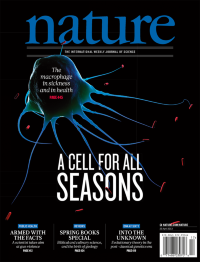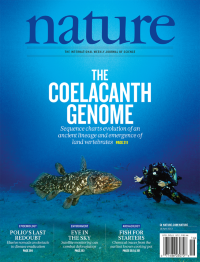Volume 496
-
No. 7446 25 April 2013
A macrophage attacking bacteria. Macrophages are phagocytic cells found in blood, lymph and in all mammalian tissue types. They have many and diverse roles in normal development, homeostasis, tissue repair and the immune response to pathogens. Their diversity means that they are involved in almost every human disease and are prime therapeutic targets because their function can be augmented or inhibited to alter disease outcome. A Review in this issue discusses macrophage physiology in terms of the homeostatic mechanisms by which macrophages contribute to physiological and pathophysiologic adaptations in mammals. Cover: SCIEPRO/SCIENCE PHOTO LIBRARY
-
No. 7445 18 April 2013
An African coelacanth and diver photographed by Laurent Ballesta in Sodwana Bay, South Africa. The African coelacanth (Latimeria chalumnae) attracted international attention when a specimen was netted off the South African coast in 1938, as coelacanths were thought to have gone extinct 70 million years ago. Now its genome has been sequenced. Phylogenomic analysis resolves the long-standing question of which lobe-finned fish is the closest living relative of the land vertebrates � it is the lungfish, and not the coelacanth. The protein-coding genes of the coelacanth are slowly evolving, which perhaps explains how similar todays coelacanth looks to its 300-million-year-old fossil ancestors. Examination of changes in genes and regulatory elements shows the importance of factors including brain and fin development, immunity and nitrogen excretion in the adaptation of vertebrates to land. Cover: Laurent Ballesta/Andromde Collection
-
No. 7444 11 April 2013
Fossil dinosaur embryos are extremely rare, and mainly restricted to the Late Cretaceous period. Hence the interest in a newly uncovered bone bed of Lower Jurassic sauropodomorph embryos from China, which at about 190 - 197 million years old is the oldest assemblage of such bones ever found. A three-year multinational programme of excavation and research has yielded a treasure trove of embryonic bones, and the oldest known evidence of organic remains. Study of bones preserved at various developmental stages indicates that these large dinosaurs had a short incubation time and flexed their muscles while still in the egg, preparing the growing skeleton for life in the outside world. On the cover, a coloured thin section of an embryonic femur showing its internal tissues and large marrow cavity.
-
No. 7443 4 April 2013
The heat wave that struck Greenland in July 2012 melted surface ice across virtually the entire ice sheet, causing extensive flooding. Ice core data suggest that such events occur only about once every 150 years on average, with the last one in 1889. Ralf Bennartz and colleagues have examined the physical mechanisms behind the 2012 event. At high elevations thin liquid-bearing clouds had an important role in enhancing surface warming, as they were optically thick enough and low enough to significantly enhance the downwelling infrared flux at the surface. At the same time they were thin enough to allow sufficient solar radiation through to raise surface temperatures above the melting point. The cover shows formations known as fog bows, or cloud bows, over the NSF mobile laboratory at Summit Station, Greenland. Fog bows are similar to rainbows but less colourful as they are caused by smaller liquid water droplets. Cover photo by Dr. Brant Miller, University of Idaho, taken in July 2012.




